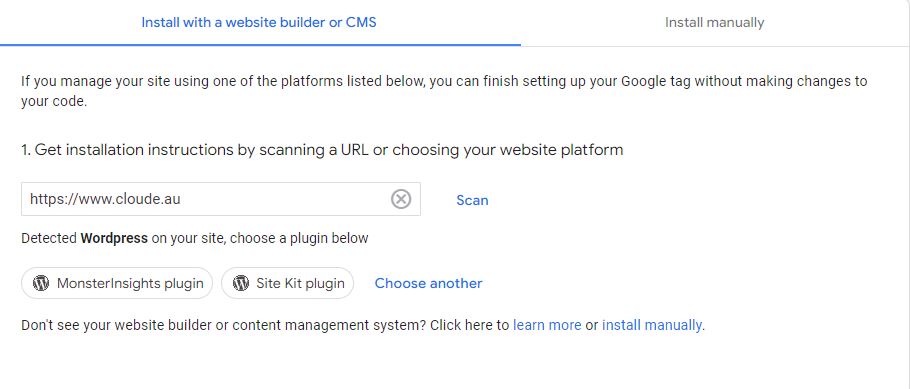SEO Checklist – To-Do List for a Beginner or Expert
Our SEO checklist is a complete list of tasks that can be performed by a beginner, intermediate or SEO expert user.
At Cloude, we understand the importance of optimising our clients’ websites for search engine rankings. That’s why we have developed a comprehensive SEO checklist that outlines a range of tasks that can be performed by users of varying levels of expertise.
If you get stuck with any items, don’t hesitate to get in touch with us for a quote.
New Website – SEO Kick Start
#1 Set up Google Analytics 4 – (Intermediate)
Google Analytics is a free tool from Google that allows you to track your website’s traffic and user behaviour.
GA integration should be always done first on your SEO checklist. Otherwise, how would you know if you have any visitors to your website?
Setting up Google Analytics is crucial in understanding how users interact with your website and how to improve its performance.
#2 Configure Google Analytics 4 in WordPress – (Intermediate)
Once you have set up Google Analytics 4 (GA4), the next step is to install the tracking code on your website. This will allow you to start collecting data on your website’s traffic and user behaviour.
After you installed Google Analytics with Google, you get a “measurement id”.
There are two options to associate your website with GA4:
1) Install a WordPress Plugin, e.g. MonsterInsights or Site Kit, or
2) Insert a code snippet provided by google on your website.

#3 Set up Google Search Console – (Intermediate)
Google Search Console is a free tool from Google that allows you to monitor your website’s performance in search results. Setting up Google Search Console is an important step in optimizing your website for SEO.
In Google Search Console, you can do the following:
- submit new pages/posts for indexing
- validate your pages if they are mobile usable
- submit your website sitemap
- validate Core Web Vitals
- check website performance
#4 Set up Bing Webmaster Tools – (Easy)
Bing Webmaster Tools is a free tool from Microsoft that allows you to monitor your website’s performance in Bing search results.
Setting up Bing Webmaster Tools is another important step in optimizing your website for SEO.
#5 Install and configure SEO RankMath plugin – (Intermediate)
RankMath is a well-known and widely used SEO plugin for WordPress, designed to assist website owners in optimizing their content and pages for search engines.
By installing RankMath on your website, you can significantly enhance your on-page optimization, resulting in improved search engine optimization (SEO) and higher search engine rankings.
#6 Create a Sitemap – (Easy)
A sitemap is a file that lists all the pages and posts on your website and is used by search engines to understand the structure of your site.
Creating a sitemap is an important step in making sure all your pages are indexed by search engines.
#7 Submit the Sitemap – (Easy)
After creating a sitemap, the next step is to submit it to search engines like Google and Bing. This will help search engines discover all the pages on your website and make them more visible in search results.

#8 Disable ‘Discourage Search Engines from Indexing This Site’ – (Easy)
By default, WordPress has a setting that allows you to discourage search engines from indexing your website. This option can be found under the “Reading” section in the WordPress dashboard.
However, it is important to ensure that this option is not selected, as it can prevent your website from being visible in search results.
If the “Discourage search engines from indexing this site” option is selected, search engines will not crawl or index your website.
This means that your website will not appear in search results, and potential visitors will have a hard time finding your website.
Therefore, it is crucial to make sure that this option is not selected, especially if you want your website to be visible and accessible to your target audience.
#9 Create a Robots.txt file – (Intermediate)
A robots.txt file is a simple text file that instructs search engine crawlers which pages on your website they should avoid crawling or indexing. This file can be used to prevent search engines from indexing pages that are not important or relevant to your website’s overall SEO strategy.
Creating a robots.txt file is an essential step in ensuring that search engines are not crawling unnecessary pages on your website, which can have a negative impact on your website’s search engine rankings.
If you installed RankMath SEO plugin, the Robots.txt file is created automatically for you.
#10 Monitor for ‘Manual Actions Issued Against Your Site’ – (Intermediate)
It is crucial to check whether your website has any manual actions issued against it by Google to ensure that your website is not penalized for any spammy or harmful content. Google can issue manual actions against websites that violate their guidelines, resulting in a drop in search engine rankings or even complete removal from search results.
Fortunately, you can check for manual actions using Google Search Console.
Keywords
#11 Create a keyword list – (Expert)
One of the crucial steps in optimizing your website for search engine optimization (SEO) is to create a list of relevant keywords.
A keyword list, which is part of each SEO strategy, is a list of terms that are relevant to your website’s content and that your target audience is likely to use when searching for products or services related to your business.
By creating a keyword list, you can optimize your website’s content and ensure that it is visible to your target audience.
To create a keyword list, you can start by brainstorming a list of terms that are relevant to your business.
You can also use keyword research tools, such as Google Keyword Planner, Semrush or ahrefs, to identify relevant keywords and estimate their search volume.
Once you have a list of relevant keywords, you can use them to optimize your website’s content, including your website copy, meta tags, and image alt tags.
#12 Using Google intuitive search to find new keywords – (Easy)
Google’s search engine provides an intuitive feature called search suggestions that can be an excellent source of new keyword ideas.
By typing in your target keyword, you can see what other related terms people are searching for and add them to your keyword list.
This feature is particularly useful when you are conducting keyword research and trying to identify new search terms that are relevant to your website or business.
Google’s search suggestions can provide insights into the search terms and phrases that your target audience is using to find information related to your products or services.
#13 Find Google question – (Easy)
To find popular Google questions related to a specific topic, you can use the “People also ask” feature in Google search results.
This feature displays a list of questions related to your search term and provides additional search suggestions based on those questions.
By using this feature, you can identify common questions that users are asking about a particular topic, and create content that provides valuable answers to those questions.
Additionally, using popular Google questions as part of your keyword research can help you identify relevant search terms and improve your website’s visibility in search engine results pages.
On top of it, you can also find useful questions on websites like AlsoAsked or AnswerThePublic.
#14 Get monthly statistics for the new keyword list – (Expert)
It’s important to know the monthly search volume and competition level for the keywords on your list. This will help you prioritize your efforts and focus on the terms that will bring the most traffic to your website.
Monthly search volume refers to the number of times a specific keyword is searched for in a given month.
Competition level, on the other hand, refers to the level of competition for a particular keyword in search engine results pages.
To pull monthly statistics for your website you can use paid tools like Semrush or Ahrefs.
SEMrush and Ahrefs are paid tools that provide more comprehensive keyword research data, including search volume, competition level, keyword difficulty, and related keywords.
These tools also offer additional features such as competitor analysis, backlink analysis, and content analysis that can help you improve your website’s overall SEO performance.
#15 Steal the competitor’s keyword list along with stats – (Expert)
Checking out your competitor’s keyword list can be a great way to find new keyword ideas and get insights into their SEO strategy.
You can use tools like SEMRush or Ahrefs to see what keywords your competitors are ranking for. Then, you can use those keywords to write better content on your website.
Competing against your main competitors is usually part of a month-to-month SEO strategy that can possibly result in beating the stronger websites after six to twelve months and generating more organic traffic.
#16 Add low, medium, and high-volume keywords on the keyword list – (Expert)
It is important to keep in mind that SEO is a long-term game, and it may take time to see results. To ensure success, it is recommended to include a range of keywords that cover tried-and-tested terms, trending topics, and future trends.
By including a mix of keyword volumes in your list, you can track the growth of your website and gain valuable insights into which keywords require more effort.
This approach can help you prioritize your efforts and focus on the most valuable and achievable terms, improving your website’s visibility and attracting more traffic to your site.
#17 All H1 & H2 headers to include keyword + location – (Easy)
Including your target keyword and location in your H1 and H2 headers can help you rank higher in local search results. Make sure to include your keyword in your headers, but don’t overdo it or it may look spammy.
If you run a local business make sure to include it in H1 and H2 headers on your main pages. This way you let Google know about your business.
#18 Main keyword in the first 100 words on the page – (Easy)
Including your main keyword within the first 100 words on your page can help search engines understand what your content is about. This is an important on-page optimization factor.
This rule applies to all pages and posts.
#19 Include the main keyword in your anchor text – (Easy)
Using descriptive anchor text that includes your keyword is important for both SEO and user experience. Avoid generic anchor phrases like “click here” and instead use descriptive text that tells users what they will find when they click the link.
#20 Image file name and alt tag must include your keyword – (Easy)
Including your keyword in your image file names and alt tags can help search engines understand what your images are about. This is an important on-page optimization factor for images.
Technical SEO
#21 Instal an SSL certificate – (Expert)
An SSL certificate is important for website security and can also improve your SEO. Make sure to install an SSL certificate on your website to enable HTTPS.
#22 Use HTTPS – (Expert)
Using HTTPS is important for website security and can also improve your SEO. Make sure to use HTTPS on your website to encrypt user data and improve user trust.
#23 Check if your website is crawlable – (Expert)
Ensuring that your website is easily crawlable by search engines is a crucial step in optimizing your website for SEO.
The Google Search Console’s URL Inspection Tool is a valuable resource that can help you check if your pages are being indexed and identify any issues that may be preventing search engines from crawling your site.
#24 Fix any broken images – (Expert)
Broken images can harm your user experience and negatively impact your SEO. Make sure to fix any broken images on your website to improve your site’s performance.
#25 Fix 404s or broken pages and links – (Expert)
Having 404 pages or broken links on your website can negatively impact your website’s user experience and SEO.
Broken links can frustrate users, leading them to abandon your website and potentially harming your search engine rankings.
That is why it is essential to regularly check your website for broken links and 404 pages and fix them promptly.
#26 Fix any crawl errors – (Expert)
Crawl errors can harm your website’s performance and SEO. Use Google Search Console to find and fix any crawl errors on your website.
#27 Make the site fast or faster – (Expert)
A fast website is important for user experience and SEO. Make sure to optimize your website’s speed by compressing images, minimizing code, and using a fast hosting provider.
One of the crucial steps in optimising website speed is fixing Core Web Vitals.
#28 Score above 80 on ‘Mobile’ Using Google PageSpeed Insights – (Expert)
Having a fast mobile website is important for user experience and SEO.
Use Google PageSpeed Insights to check your website’s mobile speed and make necessary improvements.
#29 Disavow toxic backlinks using ‘Disavow Links’ tool on GSC – (Expert)
Toxic backlinks can significantly harm your website’s SEO performance by affecting your website’s credibility and authority. It is essential to regularly monitor your website’s backlinks and disavow any toxic backlinks that may be negatively impacting your website’s SEO.
Google Search Console’s ‘Disavow Links’ tool is a valuable resource that can help you disavow toxic backlinks pointing to your website. This tool allows you to submit a list of URLs that you want Google to ignore when evaluating your website’s ranking.
However, note that abusing this tool may result in penalising your website as well.
Before using this tool read the Google guideline – How to disavow links.
#30 Ensure the site is accessible at one domain – (Expert)
Having multiple domains for the same website can harm your SEO. Make sure to redirect all other domains to one primary domain to avoid duplicate content issues.
#31 Check if the site is ‘Mobile’ friendly and responsive – (Expert)
Having a mobile-friendly and responsive website is important for user experience and SEO. Make sure your website is optimized for mobile devices and adjust your design accordingly.
#32 Use short URLs targeting one keyword – (Easy)
Short and descriptive URLs can improve your SEO and user experience. Use URLs that target one keyword and location to help search engines understand your content.
In general, the URL format should be no longer than 75 characters and have this format: my-keyword
#33 Create title & meta description using RankMath plugin – (Intermediate)
Creating optimised title and description tags is important for SEO. Use the RankMath plugin to create unique and descriptive tags for each page.
The meta description should be no longer than 160 characters
#34 Write a catchy title tag targeting one keyword – (Easy)
Your title tag is an important on-page optimization factor. Make sure to write catchy and unique titles that target one keyword and location.
#35 Every page has to have a unique title tag – (Easy)
Having unique title tags for each page is important for SEO. Make sure that every page on your website has a unique and descriptive title tag.
#36 Persuasive page and description – (Intermediate)
A compelling page and description can improve your click-through rate and SEO. Make sure to write unique and descriptive content that includes your target keyword and city.
#37 Unique page description – (Easy)
Having unique page descriptions for each page is important for SEO. Make sure that every page on your website has a unique and descriptive page description.
#38 Connecting social icons to proper accounts – (Intermediate)
Connecting your social icons to the proper accounts can improve your website’s credibility and user engagement. Make sure that your social
Content
#39 Aim for 1200+ words of text per site page – (Intermediate)
Make sure each page on your website has at least 1200 words of text. This helps search engines to better understand the content on your site and can improve your search engine rankings.
#40 Provide accurate and up-to-date information – (Easy)
Ensure that the information on your site is accurate and up-to-date. Outdated or incorrect information can harm your credibility and negatively impact your search engine rankings.
#41 Clear ‘Call to Action’ in hero – (Intermediate)
Include a clear and compelling ‘call to action’ (CTA) in the hero section of your website. This will encourage users to take the desired action, such as making a purchase, filling out a form, or contacting your business.
#42 Organised headers with spacing between sections – (Expert)
Organizing the content on your website is a crucial aspect of creating a positive user experience.
By using clear headers and appropriate spacing between sections, you can improve the readability and navigation of your website’s content, making it easier for users to understand and engage with your website.
As easy as it sounds this is not such an easy task as the optimisation has to be applied to a wide range of devices, including desktop computers, laptops, tablets, and smartphones.
This task is usually performed by an experienced website developer.
#43 Engaging and friendly writing – (Intermediate)
Write your content in a natural and engaging way, avoiding overly technical or robotic language. This will make your site more appealing to users and help improve your search engine rankings.
#44 Image optimisation – (Easy)
Optimise your images by ensuring they are no wider than your site page (1920px) and compressed for faster loading times. This will improve user experience and site performance.
Use tools like Optimizilla to compress your images.
#45 Regular updates – (Intermediate)
Make updates to your site at least every 30 days to keep the content fresh and relevant. This signals to search engines that your site is active and can help improve your search engine rankings.
#46 Video content – (Intermediate)
Include video content on your site to engage users and provide additional value. Video content can also help improve your search engine rankings.
#47 New blog posts – (Easy)
Regularly publish new blog posts to your site to keep your content fresh and relevant. This can help improve your search engine rankings and drive more traffic to your site.
We recommended having a minimum of 4 blog posts each month.
#48 Blog Archive Page – (Intermediate)
A blog archive is a separate page that lists your blog posts.
A blog archive page is an essential tool that allows you to showcase your expertise in your field, by displaying a comprehensive collection of your articles and insights on your website.
With an informative and confident writing style, we will outline the benefits of having a blog archive page and how it can enrich your online presence.
SEO Checklist – Summary
In conclusion, the SEO checklist is an essential tool for any website owner who wants to improve their online visibility and attract more traffic to their business.
By following this SEO checklist, you can ensure that their site is fully optimised for search engine rankings and that they are achieving the desired results.
Some of the items on our SEO checklist can be difficult or time-consuming, so don’t hesitate to seek help from one of our SEO Specialists in Fortitude Valley.



